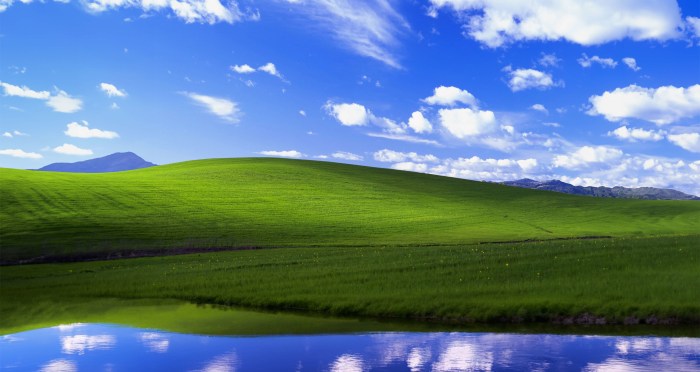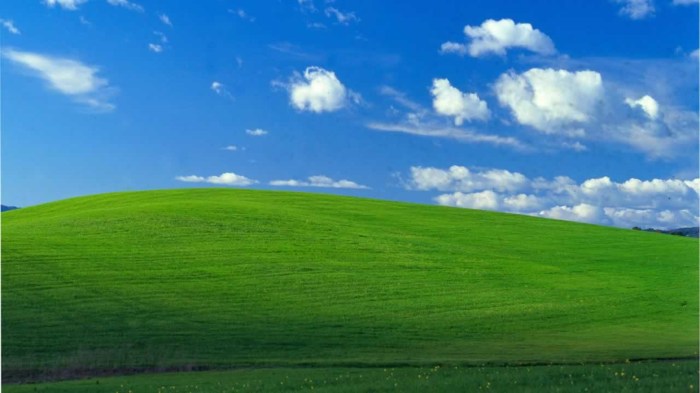The Rise of the “Bliss” Wallpaper
The “Bliss” wallpaper, the iconic image of a rolling green hill and a bright blue sky that graced the desktops of millions of Windows XP users, is more than just a pretty picture. It’s a testament to the power of visual design and the impact it can have on the perception of a product.
The story of “Bliss” begins with Charles O’Rear, a photographer who captured the image in 1996 while driving through the Napa Valley in California. O’Rear, a landscape photographer, was struck by the beauty of the scene and decided to photograph it. Little did he know that this image would become one of the most recognizable images in the world.
The Creation of “Bliss” and the Initial Agreement with Microsoft
O’Rear sold the rights to the image to a stock photo agency, Corbis, which later licensed it to Microsoft for use as the default wallpaper for Windows XP. The initial agreement with Microsoft was a standard licensing agreement, with no special stipulations or guarantees of future use or recognition.
The Impact of “Bliss” on the Perception of Windows XP
The “Bliss” wallpaper became synonymous with Windows XP, and its serene and optimistic aesthetic helped to create a positive impression of the operating system. The image, with its vibrant colors and calming scenery, conveyed a sense of simplicity, accessibility, and user-friendliness, aligning perfectly with Microsoft’s vision for Windows XP.
Negotiating a Better Deal
The photographer who captured the iconic “Bliss” image, Charles O’Rear, initially agreed to a one-time licensing fee from Microsoft for its use as the default wallpaper in Windows XP. This agreement likely seemed straightforward at the time, but as the popularity of Windows XP soared, the photographer may have realized the potential for greater financial gain.
The initial agreement was likely based on the photographer’s understanding of the image’s potential use at the time. He may not have anticipated the widespread adoption of Windows XP and the global recognition his photograph would achieve.
Factors Influencing the Desire for a Better Deal
The photographer’s desire for a better deal could have been driven by several factors.
- The Image’s Global Recognition: The “Bliss” image became synonymous with Windows XP, appearing on millions of computers worldwide. This widespread exposure significantly increased the image’s value and potential for licensing revenue.
- Microsoft’s Continued Use of the Image: Microsoft’s continued use of the image in various products and marketing materials likely generated substantial revenue for the company, while the photographer received only a one-time payment.
- The Image’s Enduring Popularity: Even after Windows XP’s official end-of-support in 2014, the “Bliss” image remained popular, suggesting its value continued to grow over time.
Potential Arguments for Renegotiation
The photographer could have presented several arguments to renegotiate the terms of the agreement.
- The Image’s Continued Use: The photographer could argue that Microsoft’s continued use of the image beyond the initial licensing agreement warrants additional compensation. He could point to the ongoing use of the image in various products and marketing materials.
- The Image’s Increased Value: The photographer could highlight the image’s increased value due to its global recognition and enduring popularity. He could present evidence of its use in various media and its continued presence in popular culture.
- Microsoft’s Revenue Generation: The photographer could argue that Microsoft’s significant revenue generated from Windows XP and its related products, in part due to the use of the “Bliss” image, justifies a more equitable share of the profits. He could present evidence of Microsoft’s financial performance during the time Windows XP was in use.
The Impact of the “Bliss” Wallpaper’s Popularity: Windows Xp Wallpaper Photographer Wishes Negotiating A Better Deal With Microsoft
The widespread adoption of “Bliss” as the default wallpaper for Windows XP had a profound and lasting impact on Charles O’Rear, the photographer who captured the iconic image. It propelled him into the public eye and transformed his career, but the consequences were both positive and negative.
The Photographer’s Enhanced Reputation and Recognition
The “Bliss” wallpaper, with its serene landscape and inviting atmosphere, became synonymous with Windows XP. It was instantly recognizable to millions of users worldwide, and as a result, Charles O’Rear’s name became inextricably linked to the image. This association brought him widespread recognition and established him as a photographer with a unique ability to capture captivating scenes.
The Photographer’s Increased Visibility and Opportunities
The global popularity of “Bliss” opened doors for O’Rear, generating opportunities for exhibitions, speaking engagements, and collaborations. His work gained wider exposure, leading to new clients and projects. The wallpaper’s success served as a powerful marketing tool, showcasing his talent and attracting attention to his other photographic endeavors.
The Financial Benefits of “Bliss”
The “Bliss” wallpaper generated significant financial benefits for O’Rear. He received royalties from Microsoft for its use, although the exact amount remains undisclosed. The image’s widespread use also contributed to the increased value of his other photographic works, enhancing his overall earning potential.
The Drawbacks of “Bliss”
While “Bliss” brought O’Rear fame and fortune, it also presented certain drawbacks. The image’s overwhelming popularity overshadowed his other works, making it challenging to establish himself as a photographer with a diverse portfolio. The constant association with “Bliss” could be seen as limiting his creative freedom and potentially hindering his ability to explore new photographic styles.
The Potential for Future Work
The popularity of “Bliss” could be a double-edged sword for O’Rear’s future work. While it brought him recognition and opened doors, it could also lead to expectations that he would continue to produce similar images. This could limit his artistic exploration and potentially hinder his ability to develop a unique style that goes beyond the iconic landscape.
The Ethics of Image Usage
The use of copyrighted images in commercial products raises ethical concerns about fair compensation and respecting the rights of creators. While companies often seek to acquire images for minimal cost or even without permission, photographers deserve recognition and fair compensation for their creative work.
Fair Compensation for Photographers
Fair compensation for photographers is crucial because it acknowledges the value of their artistic skills, time, and effort invested in creating the image. Photographers often spend hours or even days planning, shooting, and editing their work, and their images are often used to enhance the visual appeal and marketability of products. The use of their images can generate significant revenue for companies, making it essential that photographers are fairly compensated for their contributions.
“The value of a photograph lies not only in its technical execution but also in the photographer’s artistic vision and the effort they put into capturing the moment.”
Examples of Successful Negotiations, Windows xp wallpaper photographer wishes negotiating a better deal with microsoft
Several photographers have successfully negotiated better deals with companies, demonstrating that fair compensation is achievable. One example is the case of photographer David Yarrow, whose iconic photograph of a lion was used by a luxury car manufacturer in an advertising campaign. Yarrow negotiated a significant licensing fee and a royalty agreement based on the sales generated by the campaign, ensuring that he received a fair share of the profits generated by the use of his image.
- Negotiate licensing fees: Photographers should strive to negotiate licensing fees that reflect the value of their work and the potential revenue generated by its use.
- Royalty agreements: Royalty agreements ensure that photographers receive a percentage of the profits generated by the use of their images over time, providing ongoing compensation for their work.
- Attribution and credit: Photographers should insist on attribution and credit for their work, ensuring that their name is associated with the image and that they receive recognition for their creative contribution.
Windows xp wallpaper photographer wishes negotiating a better deal with microsoft – O’Rear’s story is a reminder that even the most iconic images can be subject to complex negotiations and ethical considerations. His experience highlights the importance of artists and creators advocating for fair compensation for their work. While the “Bliss” wallpaper might be a simple image to some, it represents a powerful story of artistic creation, commercial success, and the ever-evolving relationship between artists and the companies that utilize their work. Ultimately, O’Rear’s journey underscores the need for a more transparent and equitable approach to image usage in the digital age.
Imagine being the photographer who captured that iconic Windows XP wallpaper, only to realize you never got a proper cut of the deal. It’s a bit like how Overwatch’s latest character hopes to address diversity criticisms – they’re trying to make a statement, but ultimately, they’re hoping to get a bigger slice of the pie. Maybe the Windows XP photographer can learn a thing or two from this new character, and finally get the recognition (and royalties) they deserve!
 Standi Techno News
Standi Techno News

